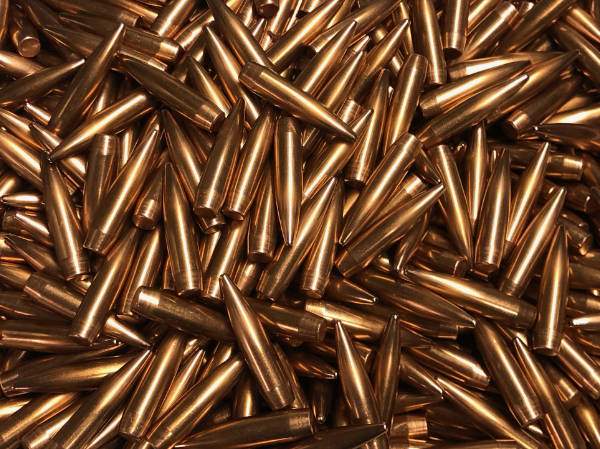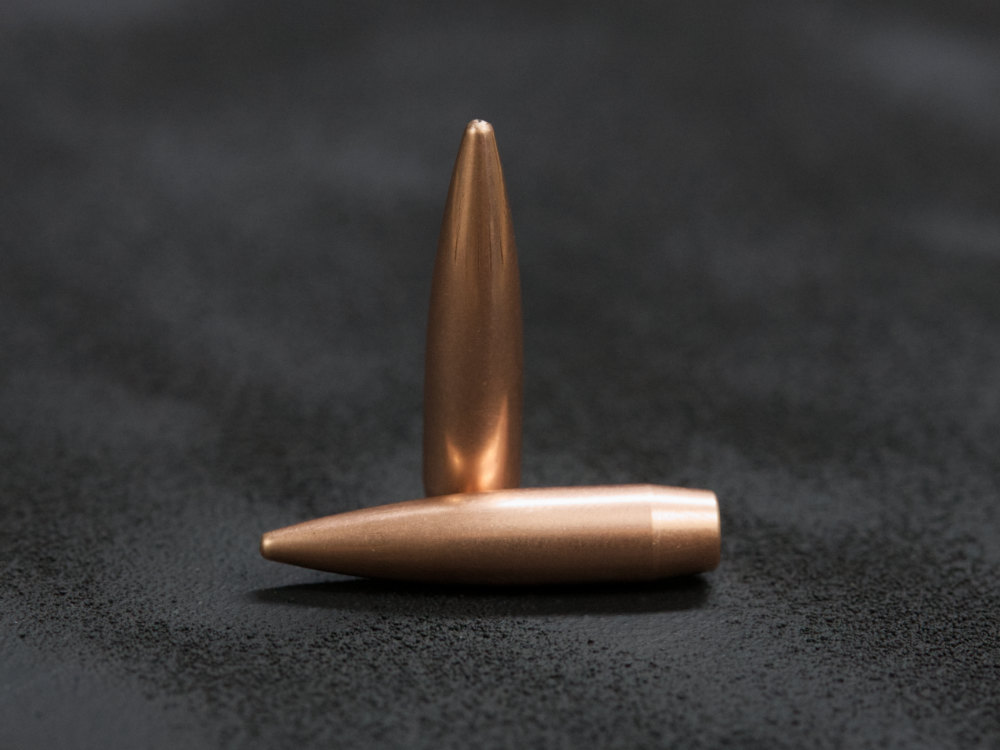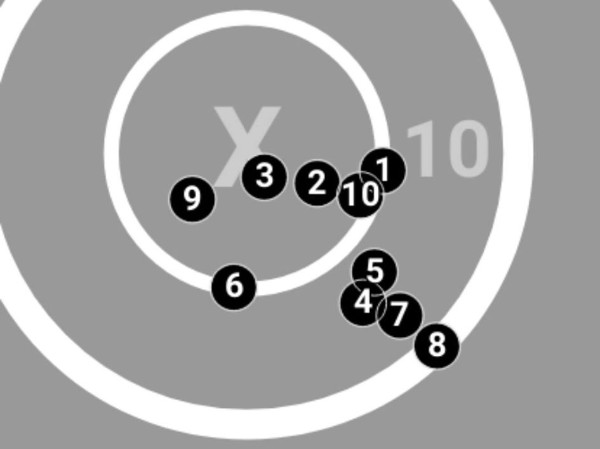The Bison Ballistics Claymore
Custom Benchrest and F Class Bullets
The Bison Ballistics Claymore incorporates an easy to tune tangent ogive and a hemispherical point to reduce drag and enhance ballistic consistency. Available in .30 caliber and 6mm, the Claymore design maintains a competitive BC in a compact package, allowing for exceptional accuracy and consistency.
Lead Times
All bullets are hand made, and lead times may be significant. Please check the lead times page for current estimates.



Detailed Specifications
Data assumes ICAO standard atmosphere: 59°F, 29.92 mmHg, 0% humidity, sea level
Twist and Jump Sensitivity assume a muzzle velocity of Mach 2.5
| .30 Caliber | 6mm | |
|---|---|---|
| Model Number | CLM-30-200 | CLM-24-103 |
| Caliber | 0.308" | 0.243" |
| Weight | 200 gr. | 103 gr. |
| BC (G1) | .625 | .510 |
| BC (G7) | .317 | .260 |
| Form Factor (G1) | .482 | .498 |
| Form Factor (G7) | .950 | .977 |
| Twist at Sg = 1.0 | 12.5 inches/turn | 9.2 inches/turn |
| Twist at Sg = 1.5 | 10.2 inches/turn | 7.5 inches/turn |
| Aerodynamic Jump Sensitivity at Sg 1.0 | .131 | .130 |
| Aerodynamic Jump Sensitivity at Sg 1.5 | .161 | .159 |
| Length | 1.418" | 1.220" |
| Custom Drag Model (.drg format) | Download View | Download View |
| QuickLOAD Bullet File (.bul format) | Download View | Download View |
| Buy Now | Buy Now |
Aerodynamic Data: .308 200gr Claymore
Aerodynamic Data: .243 103gr Claymore
Frequently Asked Questions
Claymore
How does the hemispherical tip help?
For bullets of a given length, a hemispherical meplat is a lower drag configuration than a flat nosed design. It's not a huge difference - something on the order of 0.010 of BC, but it's an improvement. If you look carefully, you'll notice that plastic tipped bullets from the majors have rounded tips - not sharp or flat. This is one reason why. Additionally, the forming operation used to make the Claymore creates exceptionally small bullet-to-bullet variation in length, which makes for increased ballistic consistency and precision.
Is the Claymore a tangent ogive or secant ogive?
The Claymore is a long-nosed tangent ogive design. Many competitors prefer a tangent ogive, and believe that they are easier to tune than a secant ogive. The Claymore aspires to be the most consistent long range bullet in its class, and a tangent ogive is the better way to achieve that goal.
What twist rate is recommended for the Claymore?
At a muzzle velocity of Mach 2.5 (about 2,787 fps) in standard sea level atmospheric conditions (59 ºF, 0% humidity, and 29.92 mmHg), a 10" twist is required to get to an Sg of 1.5. That's a very conservative number. For most shooters under most conditions an 11" twist is a better option. In some cases, a 12" or even 13" twist will be optimal. To help figure out what twist rate suits your application best, check out the Stability Calculator.
Is the Claymore pointed at the factory?
No. The Claymore is designed specifically not to be pointed or trimmed. The Claymore's hemispherical tip is already close to the optimal design for this bullet. While it's certainly possible to run one into a pointing die, we haven't done it, and cannot say what will happen if you do. Doing so will void the warranty.
What is the recommended freebore for the Claymore?
The Claymore has a nominal bearing surface length of .320". Freebore in the range of .120"-.170" should work well, but they can be used in chambers as long as .200" if you are comfortable seating them long, or as short as 0.050" if you don't mind seating them a little deeper.
Can the Claymore be seated to magazine length in a .308 Winchester?
No. The nose of the Claymore is too long to seat them to magazine length.
General Product Information
Are the ballistic coefficients measured or calculated?
We know how annoying it is to find that BCs have been inflated by manufacturers. Although the marketing copy uses an aspirational "we", Bison Ballistics is a one-man shop. I don't have a Doppler radar or a fully-featured ballistics laboratory. I do have access to 1,900 yard range for testing, a Labradar, and some sophisticated engineering software. The BCs are calculated and sanity-checked by range testing and Labradar measurement. Any BC published here is and will always be the best objectively determined estimate available given the means I have at my disposal. If I find any of them to be inaccurate, they will be adjusted.
How are the ballistic coefficients calculated?
We calculate the drag coefficient as a function of Mach number, and then determine a BC that best matches the custom drag curve to a standard drag curve (G1 or G7). We find our bullets are a very close match to the G7 drag function during supersonic flight. There is typically a divergence at transonic and subsonic speeds, where it is advisable to use a custom drag model.
Do you use Army or ICAO atmospheric standards?
Any time a standard atmosphere is needed, we use the ICAO (International Civil Aviation Organization) standard.
What is jump sensitivity?
Jump sensitivity is a number that tells us how sensitive a bullet is to dispersion due to unbalance or tipping. The higher the jump sensitivity, the less accurate a bullet will be, all else equal. Jump sensitivity is dependent on twist - a higher twist will increase jump sensitivity. We provide jump sensitivity factors so that you can make relative comparisons between bullets to get an idea as to the balance between ballistic performance and accuracy potential. A higher jump sensitivity bullet will not always shoot bigger groups in any given rifle, but we find it helpful as a rule of thumb, and it helps to illustrate the accuracy loss due to faster than necessary twists. The jump sensitivity factors we report assume a muzzle velocity of Mach 2.5. For more information on jump sensitivity, take a look at the article, Jump Sensitivity Factor - A New (Old) Way to Evaluate Bullets.
My bullets are slightly lighter or heavier than the package says. Why?
Bison Ballistics bullets are all hand made. Every core is hand-swaged and weight-sorted prior to seating and point up. What this means is that not every lot will be exactly at the target weight. If the bullet's nominal weight is 200 grains, you might find one lot that weighs 200.1 and another lot that weighs 199.9. This lot to lot variation would be cost prohibitive to avoid - it's just the nature of doing everything by hand. Individual lots are of course held to tight weight tolerances.
Which is better - G1 or G7?
Our bullets are a better fit for G7 BCs. We provide G1 BCs only as a convenience so that you can compare our bullets with those from other manufacturers who use G1 BCs. For actual ballistic calculations, use a G7 BC or our custom drag models if your software supports them.
How are the minimum twists determined?
In our detailed, you'll find two minimum twist numbers. The first refers to a gyroscopic stability factor (Sg) of 1.0, which is the absolute theoretical minimum required for stable flight. The second refers to an Sg of 1.5. Based on research done by Applied Ballistics, 1.5 is the stability factor required to minimize yaw and drag. We recommend using a rifling twist that will give you an Sg of 1.5 for long-range shooting. The recommended twists are calculated for standard atmospheric conditions at sea level. In most cases, this is a conservative estimate and you can effectively use a slightly slower twist rate.
What is a .drg file?
The Lapua Edition of QuickTARGET Unlimited specifies a file format for custom drag models, which is what we have chosen to use. Unfortunately, the software is a bit out of date, but you can still use it on older systems. We've published the files anyhow, as our hope is that more ballistics calculators will adopt it or another standard format for custom drag models. If your ballistics calculator is able to use custom drag models, but requires another format, the .drg is pretty easy to convert - it's just a text file with a list of Mach numbers and drag coefficients.
What is a .bul file?
A .bul file is is a bullet data file that can be imported into the QuickLOAD internal ballistics program. It contains bullet geometry, weight, and other information needed by QuickLOAD. See the QuickLOAD user manual for instructions on how to install a .bul file and for details on the format. Our .bul file includes G7 BCs only.
Do you have loading data?
We do not have tested loading data for our bullets. We recommend that you invest in QuickLOAD and download our free .bul files. As always, and especially when using nonstandard overall lengths or wildcat cartridges, start 10% below the maximum charge weight and work up, looking carefully for signs of pressure along the way. QuickLOAD is good, but it's just software. Be safe and follow standard reloading practices. If you are new to reloading get help from an experienced reloader.